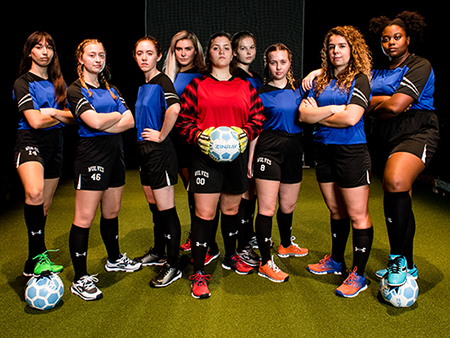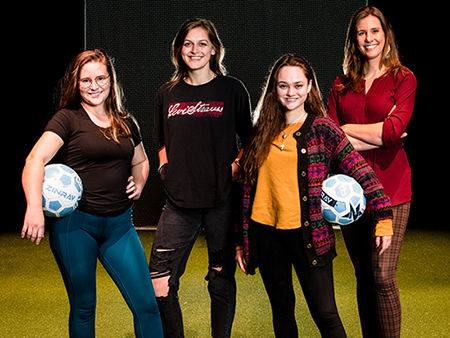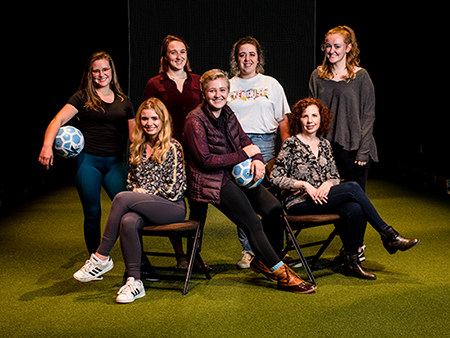 The cast of "The Wolves."It is not often that a play comes along with an all-women cast, and even rarer are opportunities that add an all-women creative team.
The cast of "The Wolves."It is not often that a play comes along with an all-women cast, and even rarer are opportunities that add an all-women creative team.
This season, Theatre UAB is doing exactly that with “The Wolves,” by Sarah DeLappe. The play is about a girls’ team of indoor soccer players, and it offers the audience a chance to see a different side of female youth, which is rarely displayed within theater.
Theatre UAB is the performance company of the University of Alabama at Birmingham College of Arts and Sciences’ Department of Theatre. The show is framed within the athletic lens of soccer, a unisex sport. Played by any gender, soccer is known to be one of the more aggressive and physically demanding sports. Author DeLappe gives the team the title of The Wolves — ferocious animals found in packs, where each member has a purpose, and together they become a collective force. Read more about the Theatre production and how to get tickets.
Members of the cast and crew weigh in on working on “The Wolves” and how this show differs from others.
Student director Camilla Almond: “I find myself constantly inspired by the ensemble nature of both the show itself and the rehearsal process. ‘The Wolves’ uniquely showcases a bond within a team sport — this is something echoed within most theatrical processes or ventures. This bond is relevant to our rehearsal process as well; I’ve experienced a sense of community that permeates both the cast and creative team. One of the show’s greatest themes, that in unity there is strength, has seemed to resonate deeply with myself and others, establishing a supportive environment both on and off the stage. L-R: Understudies Peyton Overstreet, Logan Franke, Jazzy Watson and Associate Professor Valerie Accetta, who plays the Soccer Mom.
L-R: Understudies Peyton Overstreet, Logan Franke, Jazzy Watson and Associate Professor Valerie Accetta, who plays the Soccer Mom.
“Honestly, the entirely female cast and creative team is something I forget about until I actively remember that revolutionary aspect. But when I do, I’ve realized there is a different energy in the rehearsal room for ‘The Wolves’ than I’ve experienced among other shows and rehearsal processes. I think there’s a unique sense of comfort and trust, and a sisterhood that’s extended beyond the rehearsal hall. It’s been empowering to watch those involved claim more space and more voice within their lives as well. It’s a contagious, inclusive and inspiring spirit.”
Gabriella Henry, playing #8: “Collaborating with an all-female cast and production team has been empowering because it has shown me how strong and independent we all are. It has been refreshing to study a character whose main plot point isn’t about being in love with a man, and to be a part of a show that defeats stereotypes about young women.”
Tess Lenzen, playing #25: “As a former soccer player, I’ve found it inspiring to watch my new team step into a world that I knew for 14 years. The women in this production and on the production team are the fiercest women I have met and are unapologetically themselves, just as female athletes should be. Our team has grown so much, and I cannot wait for people to see just how powerful women are and can be.”
Professor Karla Koskinen, advising director: “Being in the rehearsal hall with these women and watching the support and respect they give to one another has been an absolute pleasure. It appears that they understand and are emboldened by the significance of performing in a play where the women are not defined by their relationships to men. The performers are claiming their characters’ voices and bringing these young women to life with intelligence, courage and joy.” The creative team for "The Wolves," L-R standing: Assistant director Peyton Overstreet; student sound designer Alyssa Wilke; student lighting designer Lew Williams; stage manager Anna Whitlock; L-R seated are student director Camilla Almond; student prop master Allie Nichols; and set and costume designer Kimberly Schnormeier.
The creative team for "The Wolves," L-R standing: Assistant director Peyton Overstreet; student sound designer Alyssa Wilke; student lighting designer Lew Williams; stage manager Anna Whitlock; L-R seated are student director Camilla Almond; student prop master Allie Nichols; and set and costume designer Kimberly Schnormeier.
Associate Professor Valerie Accetta, MFA: “I have been so inspired by working with these young women. As a faculty member in the cast, I have been impressed with how Camilla and her team lead — all of these students are confident and easily communicate their vision, while also staying really open and collaborative. It’s been a beautiful process to witness.”
Associate Professor Kimberly Schnormeier, MFA, set and costumes designer: “It has been a very positive and agreeable experience overall, with everyone being very supportive of each other. It was a different experience for me since I designed both scenery and costumes for the production; it gave me an opportunity to have a larger degree of control over the visual aesthetic of the production than I usually do when I design costumes alone.”